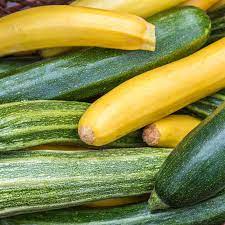by Martha Habluetzel, Aransas/San Patricio Master Gardener
Release date: March 30, 2022

With summer and winter squash selling for about $1.25 per pound in the grocery stores, coastal residents are encouraged to plant a couple of seeds or transplants to have fresh, homegrown squash. Squash plants dislike the cold and thrive on warm sunny days, and since the fear of frost has finally passed, now is the time to plant.
All squash are in the cucurbit family. Other cucurbits include melons, cucumbers, zucchini, and gourds. All require moist, well-draining soil, and more importantly need lots of room to grow. Ample nutrients added to the soil are also a must. Direct sow summer squash seeds in the garden right now until the end of April, and in about 45 to 60 days they will be ready to harvest. Winter squash takes up to 120 days to harvest; they have a hard skin that isn’t consumed.
My favorite summer squash is zucchini because it is so versatile. No need to peel them when they are 6-9″ long, just chop them up and eat raw in a salad or cooked in pasta dishes or soups. You can stuff them with sausage or cheese. You can make zucchini bread. Very large zucchini can be cut in half, stuffed with a meatloaf stuffing, and baked.
My favorite winter squash is the spaghetti squash. Its stringy strands are a fabulous alternative to pasta. You can bake it, bar-b-que it, steam it, and can even microwave it. I personally prefer to steam it. You can add sauces like you would on pasta, with or without meat. Spaghetti squash with chicken alfredo sauce is a must-have dish.
Squash does best when planted by seeds, but seedlings are okay. The last date to plant squash seeds this spring is April 10th. With this being April already, purchasing and planting squash transplants that are available will have your plants producing fruit before it gets too hot. Plant squash seeds of varieties that you can’t find transplants of, like spaghetti or acorn.
Most planting instructions on seed packets will tell you to plant three to six seeds to a “hill” and then thin to two or three plants. If you have good drainage, the “hills” do not need to be raised. Squash needs at least six hours of sunlight, but some – especially afternoon light – can be diffused light. Squash may stress when the temperature is above 85 degrees, so keep it well watered in the summer.
Squash are heavy feeders, like teenage boys with hollow legs. They grow best in rich soil enriched with composted chicken or cattle manure. Never use fresh manure or it will burn your plants, only use composed manure. As they grow, continue feeding them with compost or with two tablespoons of fertilizer, preferably all-purpose 10-10-10, per set (“hill”) of two or three plants; work the fertilizer into the top three inches of a two-foot diameter circle and fertilize once every three weeks after the plants have four leaves.
Squash needs ample room to grow. Bush plants sprawl out to a three-foot diameter circle. Vining squash puts out “tentacles” eight to twenty feet. They put down a tap root about 36” deep and can grow in raised gardens, provided there’s room for the taproot to grow downwards.
Squash are thirsty critters, but they do not like to be sitting in water. Keep the soil moist, which might mean watering every other day during dry spells. Water anytime a plant starts to wilt.
Common pests of squash are squash vine borer, squash bugs, aphids, cucumber beetles, and cutworms. Companion planting of onions, garlic, nasturtiums, and radishes will reduce the pest threat. I break up 20 bulbs of garlic into individual cloves and plant all around my squash and other plants. Watching your plants for bugs and eggs, especially on the underneath side is still necessary. Spray with neem oil per bottle directions to control the bugs.
Look for the following varieties of squash and other cucurbits that A&M Horticulture recommends for our unique climate and soil conditions: Cucumbers: (pickling) Crispy, Carolina, Liberty; (slicer) Burpless, Dasher II, Sweet Slice and Sweet Success; (dill) Bouquet and Long Island Mammoth. Squash, Summer Yellow: Multipik and Dixie. Squash, Summer Green: Zucco, Elite, Senator. Squash, Summer White: Patty Pan, St Pat Scallop. Cantaloupe: Ambrosia, Magnum 45, Mission, Perlita, TAM Dew, TAM, Uvalde, and Laguna. Watermelon: Tri-x Seedless, Royal Peacock, Allsweet, Black Diamond, Mirage, Charleston, Crimson Sweet, Dixielee, Royal Charleston, Jubilee, Royal Sweet, Calhoun Gray and Yellow Tender-sweet.
For more information about growing squash, go to https://agrilifeextension.tamu.edu/browse/featured-solutions/gardening-landscaping/squash/.
Master Gardeners is a non-profit program of Texas A&M AgriLife Extension Service. Be sure to visit our Coast Oaks Demonstration Garden: 892 Airport Rd., Rockport. Contact us: MG Helpline: 361-790-0103 ♦ Email: [email protected] ♦ Website: http://aspmastergardeners.org/ ♦ Facebook: facebook.com/aspmastergardeners ♦ Online Plant Store: https://aspmgstore.org/